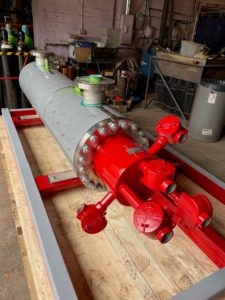Your Guide to Common Types of Heat Transfer Fluids
Last updated on July 3rd, 2023 at 04:15 pm
 Heat transfer fluids all serve the same purpose, but each type has unique thermal and chemical properties. Understanding the advantages and disadvantages of a given fluid is crucial before using it for an industrial application. This post will examine some common heat transfer fluids, their industrial applications, and how they interact with heating systems.
Heat transfer fluids all serve the same purpose, but each type has unique thermal and chemical properties. Understanding the advantages and disadvantages of a given fluid is crucial before using it for an industrial application. This post will examine some common heat transfer fluids, their industrial applications, and how they interact with heating systems.
The function of heat transfer applications
Heat transfer fluids are essentially “transport vehicles” for thermal energy (or heat)—they move heat from one component (i.e., tank) to another. Applications vary but often facilitate operations raining from heating and cooling to product manufacturing.
Selecting the right transfer fluid depends on its thermal properties, which include its viscosity, heat capacity, the heating system it’s used in, and the application itself. With those factors in mind, it’s important to note there are hundreds of heat transfer fluids available, some or many of which may be suitable for your application.
Types of heat transfer fluids
No heat transfer fluid is inherently “good” or “bad.” They only are advantageous or disadvantageous depending on the application they’re used for and how. Again, deciding which fluid to use boils down to understanding its properties.
Water
Water, as basic as it may seem, can be a highly effective heat transfer fluid for many applications. It’s highly conductive and boasts high heating capacity. For that reason, water is excellent for heating and cooling. However, it can also facilitate pharmaceutical production, food processing, medical equipment, and more. The one caveat with water is that it must be pure, or else impurities may clog and corrode heating equipment.
Glycol
Available as either ethylene glycol water (EGW) or propylene glycol water (PGW), glycol chemically similar and related to alcohol. Its boiling point is high and remains thermally stable even over a wide temperature spectrum. It’s also highly conductive and has a low freezing threshold. The latter characteristic makes glycol ideal as an antifreeze solution for engines, but also for food processing and pharmaceutical formulations.
Mineral oil
Mineral oils are derived from fossilized fats. Unlike their synthetic counterparts, mineral oils have high heating capacity even under low pressure. They also can absorb significant amounts of heat without changing their state. However, the most notable advantage of mineral oils is that they’re an inexpensive heat transfer fluid. This makes them suitable for industrial applications where cost efficiency might take precedence over performance factors.
Shell
Shell oils work as an excellent heat transfer fluid for advanced industrial applications. For one, it can support temperatures reaching 608°F, while still remaining thermally stable. It’s also highly solvent, possesses superb fluidity and is easy to dispose of. Shell also maintains low vapor pressures even when subjected to high temperatures.
Mobiltherm
Mobiltherm is a high-performance lubricant used for various heating and cooling systems, including ones used for heat transfer. Due to its composition, mobiltherm has high oxidative resistance and a low likelihood of cracking. It remains thermally stable under high temperatures and transfers heat with great efficiency.
Chevron
Chevron is a mineral-based oil with a unique formulation compared to other mineral oils. From a performance standpoint, it excels in terms of thermal stability and oxidative resistance, with some grades operating up to 600 °F. It’s also a great heat transfer fluid because it’s compatible with various seals and doesn’t corrode heating equipment. Chevron is a terrific option for heat transfer applications where electricity, oil, or gas is the fuel source.
Choosing the right heater for thermal fluids
 Choosing the right heat transfer fluid is essential for two reasons: 1) To maximize the performance and safety of an application, 2) to prevent heater damage. When it comes to the former, you can choose a fluid based on industry standards and what applications it’s normally used for. For example, an antifreeze application would likely need glycol or some variant of it.
Choosing the right heat transfer fluid is essential for two reasons: 1) To maximize the performance and safety of an application, 2) to prevent heater damage. When it comes to the former, you can choose a fluid based on industry standards and what applications it’s normally used for. For example, an antifreeze application would likely need glycol or some variant of it.
Naturally, the right heat transfer fluid doesn’t lead to corrosion or premature wear-and-tear of a heating system. Again, following the industry standards helps in that regard.
But when dealing with complex applications that may have multiple heat transfer options, specific calculations may become necessary. Factors such as the temperature and pressure requirements of your application, combined with the thermal properties of a fluid and the limitations of your heater need to be considered.
Here at Wattco, we build custom heaters that can support the unique heat transfer requirements of your application, using specific calculations. That ensures your choice of heat transfer fluid performs effectively, efficiently, and safely.
Get a quote for an industrial heater today. Our representatives will help you find the exact setup needed for your industrial needs.
